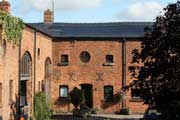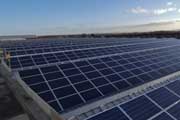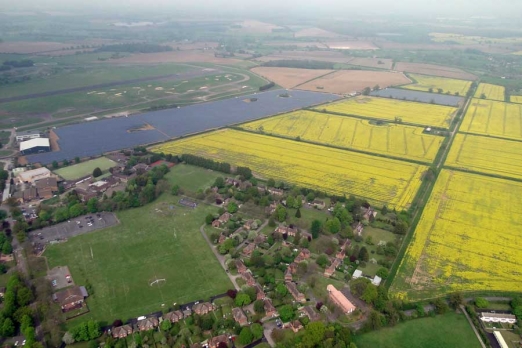An area at least twice the size of London is available, representing a huge amount of untapped solar energy potential. This would increase solar generation whilst protecting the countryside. However, the Government needs to do much more to help realise this huge potential. We recognise that solar farms have a part to play where they meet our criteria — on protecting landscape and heritage, amenity and the best agricultural land, and maximising biodiversity.
Good practice: Integrating solar energy into homes
 Solar slates were integrated into the new roof of a converted barn in Little Barrow near Chester in a way that complemented the local environment and produces low carbon electricity for the home. The building is listed and required planning consent. The installer, the Greener Group, chose Solarcentury electric slates for the 3kW project, which have been developed to work in tandem with both existing and new build slate roofs to maintain their look. This meant that the local planning authority, Cheshire West and Chester Council, gave the project the green light. The slates fitted in well with the local environment and surrounding architecture of the barn, fitted snugly onto the undulating roof, while protecting the home from the elements and producing electricity. A number of housing developers are now exploring how solar slates and other solar energy products can be integrated cost-effectively into new housing to avoid the need for retrofitting.
Solar slates were integrated into the new roof of a converted barn in Little Barrow near Chester in a way that complemented the local environment and produces low carbon electricity for the home. The building is listed and required planning consent. The installer, the Greener Group, chose Solarcentury electric slates for the 3kW project, which have been developed to work in tandem with both existing and new build slate roofs to maintain their look. This meant that the local planning authority, Cheshire West and Chester Council, gave the project the green light. The slates fitted in well with the local environment and surrounding architecture of the barn, fitted snugly onto the undulating roof, while protecting the home from the elements and producing electricity. A number of housing developers are now exploring how solar slates and other solar energy products can be integrated cost-effectively into new housing to avoid the need for retrofitting.
Good practice: Solar energy on commercial rooftops
 Bentley Motors was looking for new ways to cut their emissions and tackle the problem of rising energy costs. Its factory in Crewe had almost three and a half hectares of unused, south-facing roof space — ideal for generating solar power. Owned and operated by Lightsource, Bentley’s powerful solar system produces up to 40% of the factory’s energy requirements at peak times, reducing its energy costs. The system also cuts Bentley’s carbon emissions and gives them greater pricing certainty for the future. Siting solar energy on the roofs of commercial buildings makes good use of already developed land and helps protect the countryside. Energy used on the site is also efficient because it reduces transmission losses.
Bentley Motors was looking for new ways to cut their emissions and tackle the problem of rising energy costs. Its factory in Crewe had almost three and a half hectares of unused, south-facing roof space — ideal for generating solar power. Owned and operated by Lightsource, Bentley’s powerful solar system produces up to 40% of the factory’s energy requirements at peak times, reducing its energy costs. The system also cuts Bentley’s carbon emissions and gives them greater pricing certainty for the future. Siting solar energy on the roofs of commercial buildings makes good use of already developed land and helps protect the countryside. Energy used on the site is also efficient because it reduces transmission losses.
Good practice: Solar farm good practice in Suffolk
 An example of a well-sited and well-designed solar farm, which was supported by CPRE’s Suffolk branch — the Suffolk Preservation Society — is on a site near Fakenham Magna in Suffolk. The application was for an 11MW solar farm on a 22 hectare site, less than half the area originally proposed, which significantly reduced its visual prominence. The Society concluded that the scheme would have a negligible impact on public views as it was well screened by mature hedgerows and the local topography, and it is on lower quality agricultural land. The local planning authority, St. Edmundsbury Council, approved the application in December 2012 and the solar farm began generating electricity on 1 April 2014. The energy produced goes into the grid via the Honington village substation to be used in the village and any surplus is exported elsewhere.
An example of a well-sited and well-designed solar farm, which was supported by CPRE’s Suffolk branch — the Suffolk Preservation Society — is on a site near Fakenham Magna in Suffolk. The application was for an 11MW solar farm on a 22 hectare site, less than half the area originally proposed, which significantly reduced its visual prominence. The Society concluded that the scheme would have a negligible impact on public views as it was well screened by mature hedgerows and the local topography, and it is on lower quality agricultural land. The local planning authority, St. Edmundsbury Council, approved the application in December 2012 and the solar farm began generating electricity on 1 April 2014. The energy produced goes into the grid via the Honington village substation to be used in the village and any surplus is exported elsewhere.




